THE DEBUT OF TELEVISION IN RATON
By Pat Veltri
(In Memory of Wally and Utha Clark)
For several days in the early part of 1953, rumors abounded in Raton as townspeople pondered why officials from ARF Products Inc., a Chicago based electronics firm, were making nightly visits to Raton’s mountaintops. At a Raton Chamber of Commerce meeting on February 2, 1953, Arthur Maciszewski, President of ARF, revealed that his company was investigating the possibility of bringing television to Raton. He confirmed rumors that his company was conducting tests on several elevated points in the area to determine the ideal spot to position an antenna for adequate television signal. Testing was limited to afternoon and night because that’s when television broadcasts from the Colorado Springs area were transmitted.
At the same meeting, according to an article in The Raton Daily Range, Maciszewski also disclosed to the chamber members, “We have definitely made up our minds to come into Raton and establish an electronics laboratory plant here.”
ARF’s plan called for the relay of television signals picked up from CheyenneMountain near Colorado Springs, Colorado, through receiving equipment north of Raton. From the receiving station the signals would be brought into town over coaxial cable.

Tests continued to be underway through March of 1953. The tests were expedited with the loan of Raton’s Christmas tree pole. The Christmas tree pole served as a portable tower, with about 50 feet of aluminum tower attached. A story in The Denver Post, quoted Maciszewski, “In one afternoon the tower was moved to nine different locations without success. Finally, the TV aerial was tied to a meteorological weather balloon and raised about 50 feet in the air. Excellent reception was received until the balloon reached 120 feet and the signals ceased.”
Convinced that TV reception was possible because of the tests conducted with the “Christmas tree tower”, ARF officials met with the Raton City Council to request a franchise. Two business men, Joe DiLisio and Paul Arthur, submitted the request for consideration, and urged the council members to approve a franchise arrangement for the eastern firm. After quite a bit of spirited discussion, the city council tabled the decision for 60 days, giving ARF an opportunity to present a written franchise to the council for assessment. Eventually the company was granted a twenty-five year franchise for television in the Raton area.
On August 16, 1953 about 50 of Raton’s citizens gathered at the Hotel Yucca for the debut of television in Raton. Maciszewski presided over the first showing. Two hours of programs were screened for the viewing pleasure of those attending. The Range reported, “Leading citizens of the community present at the showing termed the accomplishments of the ARF firm here as ‘real progress’ for Raton.”
The production of television sets was expected to get underway by October of 1953. According to The Range, Maciszewski said that the largest dollar item of a TV set, the cabinet, would be built by the Raton Development and Manufacturing Company, and “that the Raton-made TV sets will be built by citizens of your own city”.

Raton was the second city in the United States to have cable television. In a 2003 interview, Wally Clark, a long time employee of ARF, said, “The first town was back in Pennsylvania* someplace but Raton was the second town in the United States to have cable television and the reason for that was we were building a plant here and we designed our own cable television system.”
Clark noted that television was “brand new” to the citizens of Raton, unless they had seen it while visiting out of town, and they were “excited about it”. After the initial showing, Maciszewski announced that a television set would be in operation in the reception room of the Hotel Yucca every night from 7:00 to 8:30 for those Ratonians who had not seen television and would like to get an idea of what programs would be offered in the near future.
Clark came to Raton specifically to install the cable television system, and spent his first two years with the company in Raton doing just that. He began working for ARF Products in 1950, soon after graduation from DeVry Institute. At that time ARF was based in the Chicago area, which included two manufacturing plants in Melrose Place and Cicero, and a research and development plant in River Forest.
In 1952 Clark, his wife Utha, and their daughter Judy moved to Phoenix, Arizona, where he took a job working on aircraft radios at Sky Harbor Airport. About six months passed and Clark received a letter from Maciszewski asking him if he would like to work at a new plant that ARF was building in Raton. After visiting the town in March of 1953, the Clarks decided they would like to live in Raton. Three months later they were settled in a former coal camp house on North Third Street. Clark said, “The plant wasn’t completed until September so from June to September our front yard was the place that all of the stuff coming in for the TV cable system was delivered to, so we were ARF for the first three or four months of ARF’s staying in Raton. Utha was the receiving clerk, the telephone operator and everything in between.”
Clark estimated that probably around 1956 or 1957 ARF Products was completely relocated in Raton and Boulder, Colorado. Soon after building the new ARF manufacturing plant in Raton, a research and development plant was built in Boulder near the University of Colorado.
In a roundabout way the Philmont Scout Ranch, near Cimarron, NM, played a small part in bringing ARF to Raton. Maciszewski had been a Boy Scout in his native Poland and he became a leader for his son’s Chicago area Explorer troop in the early 1950s. A 1952 trip to Philmont with his son coincidentally was also his first exploratory trip out west looking for a place to either expand or relocate his business. On his way to Cimarron he stopped in Raton. Even though his company was flourishing in Chicago, Maciszewski and his associates were on the lookout for fresh prospects. An excerpt from a speech given by Maciszewski at a 1956 New Mexico Manufacturers meeting expressed his ideas, “We came here seeking new opportunities. It was the beauty of surroundings, congenial western hospitality and friendship, and the thrill of conquering the frontier in a modern way that led us to this decision. We discovered that our real opportunity was to follow the tradition of the pioneers, who developed vast western lands and made them fruitful for future generations.” While in Raton Maciszewski visited with local business leaders and explored possible property sites. Upon his return to Chicago he reported on characteristics of various locations to the other members of his company team.
In the early 1950s Raton was in need of new industries to reinforce its economy, due in part to reduced operations at the Koehler mines. Joe DiLisio, Sr., a prominent citizen of Raton, owned a bank, a department store, a hotel, and some land that would make a perfect site for Maciszewski’s business. Maciszewski and DiLisio got together and DiLisio agreed to donate ten acres of land if Maciszewski would build a plant in Raton. In a 1970 interview for the Denver Post’s Empire Magazine, DiLisio recalled, “As soon as I met Arthur, I knew he was not one of those fly-by-nights. I told him that the land wasn’t for sale, but if he would move in and open a plant that provided at least 20 jobs, I’d give him 10 acres for a dollar. I’m very pleased with the results of my offer. ARF was the salvation of this town.”
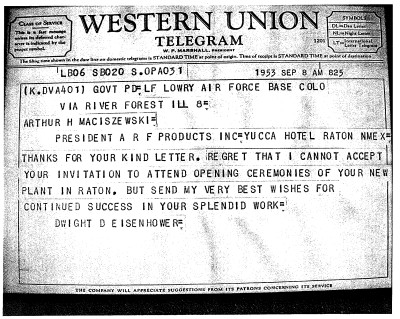
The Range stated that the formal opening of the new ARF Products, Inc. plant, built by contractor Bill Bacon, was held on September 9, 1953. Company president, Arthur Maciszewski, who officiated at the dedication, termed the opening a “community project made possible through cooperation”. Guest speakers at the affair were Sol Petrillo, director of engineering for the Signal Corps, and Senator Clinton P. Anderson (D-New Mexico). Maciszewski had extended a personal invitation to President Dwight D. Eisenhower, but the president was unable to attend. However, Eisenhower sent a telegram of congratulations to Maciszewski.
Dave Joseph was the manager of the new plant, and Frank Gabriele was the first local employee to be hired. At the time of the plant opening three local women, Lois Groves, Gertrude Kemp, and Lorraine Schuster, were already in training to learn how to assemble television sets for use in Raton.
With the help of many people in Raton and Colfax County, ARF designed a TV system for Raton. The Raton Community Television System began on top of a 100 foot tower located nine miles north of Raton, on Bartlett Mesa, just a few hundred yards south of the Colorado border. Several antennas were pointed at Cheyenne Mountain, 120 miles north and tuned to Channel 11, where KKTV of Colorado Springs had its transmitting antenna of 9300 feet. Raton’s antenna sat at an elevation of 8700 feet. The location was selected so that there were no obstacles, such as irregular terrain, between the antennas. The signal received from the Colorado Springs station was amplified by a custom built master receiver and amplifier. The amplified signal was then relayed by ten miles of coaxial cable to a sub-master station in Raton, and from there to the homes of customers.
The television viewer could purchase installation and connection to the antenna and coaxial transmission for $181.50, including federal and state taxes. Other expenses connected to the service were paid for by a monthly service charge of $4.00 per TV connection. Three television models were available – The Bartlett, La Mesa, and Pikes Peak – with prices ranging from $205 to $260 plus tax. Richard DiMarzio and the Raton Development and Manufacturing Company fabricated the cabinets for the television sets.
With the assistance of the Raton Chamber of Commerce, ARF had conducted a survey in July, 1953, via a coupon in The Range, and determined that the estimated eventual demand for television in Raton was 1000 sets. At that rate the company would be reimbursed for expenses by the time the 1000 sets were connected. Clark said that the company “came pretty close to meeting that goal” and probably sold about 800 sets.
By the end of 1953 ten televisions had been installed in homes in Raton, with seven more on order. Clark said he did not have one of the first televisions because “we weren’t making enough to supply the demand”.
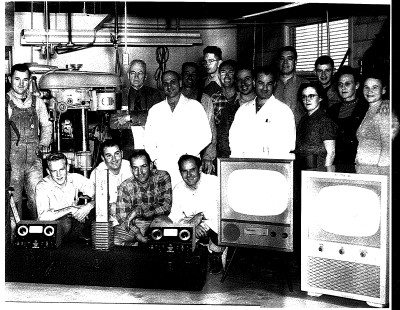
Left to right, front row: John Perkovich, Bill Groves, Frank Gabriele, John Gabriele, Ralph McCreight
Left to right, second row: Waldo Jarmin, John Owerko, Charles Gasperetti, Howard Jarmin, Basil Herndon, Wally Clark, Dave Joseph (Plant Manager), Cheto Calderon, Lois Grove, Gilbert SanRoman, Lorraine Schuster, Gertrude Kemp
In December, 1954, ARF Products Inc. announced a new model television set for Raton adapted for connection to the Raton Community Television system. A full-page promotional ad in The Range compared ARF’s engineers with Raton’s citizens saying both groups possessed “the same spirit of continuous striving for improvement”. In response to this characteristic of Ratonians and themselves, ARF’s engineers designed the Ratonia, a television set “custom engineered and styled for Raton, manufactured in Raton, and named for Raton”.
After many years of management of the thriving cable TV system, company officials wanted to expand the plant’s research and manufacturing operations, so the television franchise was sold to a private individual, Jack McConathy, of Aztec, NM. ARF president Maciszewski announced the sale in The Range on June 27, 1962. ARF pioneered television in the area and saw the system grow from a one-channel operation to a multi-channel system that was bringing service to the community for three national television networks and two FM stations.
The sale of the television cable system allowed ARF to concentrate its efforts on designing and building a wide variety of military and consumer products, ranging from radio systems, surveillance equipment, alarm systems, missile scoring equipment, microwave radio equipment, military parts, mining communications systems and more. Clark mentioned that the most notable government project was the OA 1387 land based Army Transmitter/Receiver. Other specific projects of interest were the design of the first garage door opener for the Genie Company, the development of the ARF 2001 Citizens Band Radio (which today brings a premium price on E-bay), the glide slope receiver, the ultraviolet water purifier, and the electrolytic respirometer.
According to Clark, the prime years of production for ARF in Raton spanned more than a decade, from the mid 1950s through the 1960s. He said, “We just started hiring in 1953 and then we built two wings on the plant out there so the prime years were probably from 1956 to 1968 when we hired the most people.”
Clark noted that ARF’s peak payroll was reached in the mid 1960s. He said, “We leased the Mount Capulin plant in the mid 1960s and we had 80 people working over there. We had two shifts going in the Gardiner plant and our total employment at that time was 250 people. That was the maximum that we had on the payroll at one time, was 250.”
Clark commented, “There is a place in Raton’s history for ARF because we were one of the prime employers.” About his job, he said, “I can honestly say that I never got up in the morning and dreaded to go to work in all my years that I worked, and I spent all my working life for ARF, except for about four or five months.” Clark commended Maciszewski, “Looking at Arthur Maciszewski as a person, he felt that his employees were his family. He really tried to treat them as his family.” When the plant closed on December 12, 1991 Clark, his wife Utha, and Jim Veltri were the last employees to leave.
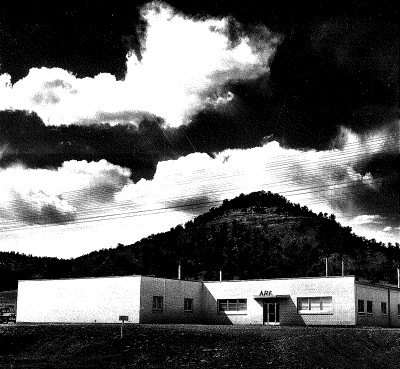
*The first cable television system in the United States was developed by John Walson in Mahanoy City, Pennsylvania in 1947.
Photos are courtesy of Jim Veltri.

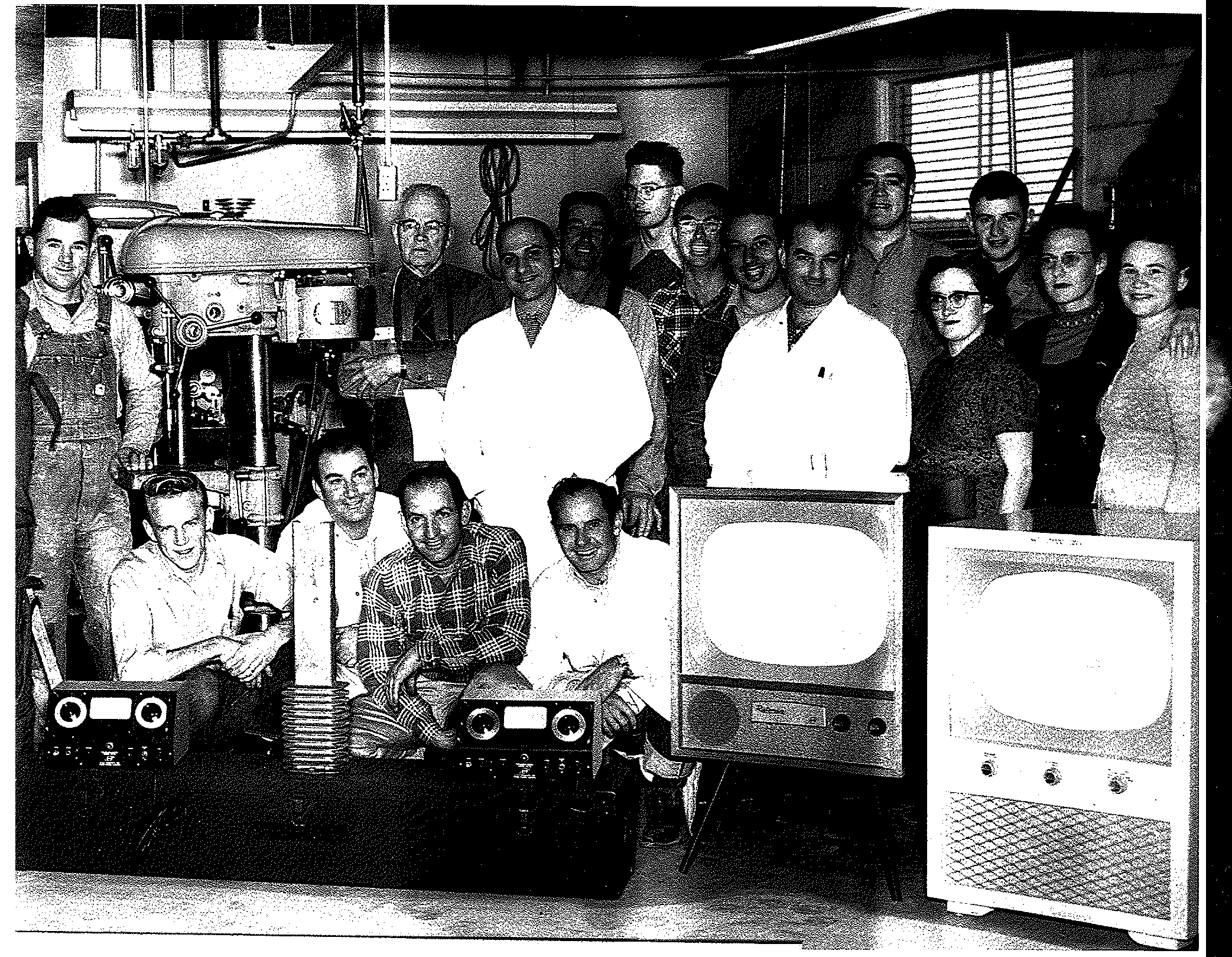
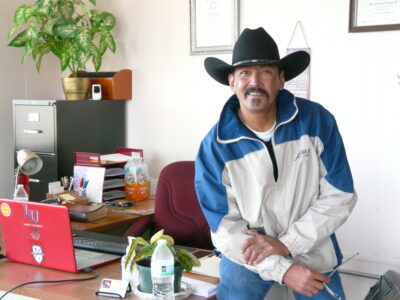
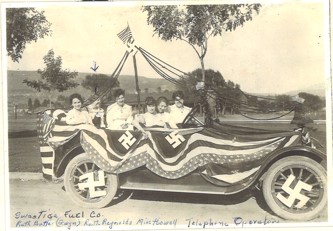


Such a well written, historical note about Raton. I’d always wondered what that building was used for- glad I thought to finally Google it today (for some reason).
I so enjoyed reading this – I learned from it as well. I worked a summer at ARF during summer breaks and enjoyed it. I helped with the payroll and office worked and it was a great bunch of people that worked there. Makes me sad to see the building now but what a great thing it was for Raton and another great story of a successful business that helped Raton prosper!
I actually had a Ratonia tv set in my rooom which worked into the late 70’s.By the way our house was built by none other than Wally Clark..
Thanks Pat for the walk down memory lane. My Mom, Pauline, was an ARF employee for nearly 30 years. The Clarks were super friends to my Mom and really was supportive after my Dads passing. As a kid. it was good to hear stories about Chicago from the folks who moved west. Bob Cronkite became a family friend. The stories produced interest in how other folks lived and worked in other parts of America. Spending time at the plant and how equipment worked tweaked my interest in the sciences and probably set me on the direction of being a science teacher. Even worked one Christmas during college folding/stapling shipping boxes. ARF was a family away from home for the employees.
Thanks for the history lesson! I still remember going up on Bartlett Mesa with my dad, Milt Riddiford, (VP at ARF for nearly 45 years). Many times we had to travel by tracked personnel carrier (Artic Cat) due to the amount of snow on the mesa; once in a most awesome blizzard to reset and re-calibrate the antenna.
Thank you for this article, very informative!
What a wonderfully nostalgic read! I actually didn’t realize that ARF developed the second only cable television relay in the US. I knew that my dad and his team brought television to Raton for the first time, and I remember the Ratonia model. What a world away this seems, now that we’re firmly planted in the digital age. Thank you for this vivid snapshot of the history of communications electronics, of Raton, and of my family!
Cheers!
Very good article, Pat! Thank you for all your time and hard work.
Thanks Pat for the great article. Brings back a lot of good memories of the years I worked for Arthur.
Excellent article I remember well the early days of cable television in Raton, one channel, one network and naturally black and white.